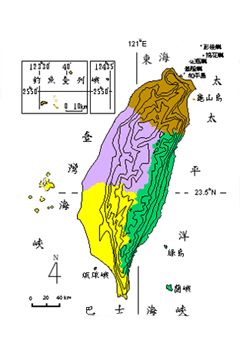The Economic Geography of Taiwan

Relevant Websites
- Tai-wan-de-gu-shi-jing-ji-pian
- Council of Agricultural Development Exetive Yuan R.O.C.
- Board of Foreign Trade
- Taiwan's Economic Development and Outlook
- The Economics of Taiwan
- History of Economic Development in Taiwan
- ECONOMIC ACHIEVEMENT (Taiwan Provincial Government)
- Taiwan Trade and Economic (Washington State Taiwan Office)
- THE TAIWAN MIRACLE (NYUST Department of Applied Foreign Languages)
Reference
- Tai-wan-yin-hang-jing-ji-yan-jiu-shi, 1956: Tai-wan-kuang-ye-te-ji,Tai-wan-ji-kan, Vol. 8, no. 3, pp.1-105.
- Wang, hung-wen, 1974: Tai-wan-neng-yuan-zhi-di-li-feng-xi, Tai-da-di-li-xi-yan-jiu-bao-gao, no. 8, pp. 93-129.
- Huang, Chih-hui, 1975: Tai-wan-di-qu-dui-wai-mao-yi-zh-fa-zhan, Tai-wan-yin-hang-ji-kan, Vol. 26, no. 4, pp. 73-104.
- Ho, Chun-sun, 1986: Tai-wan-de-mei-kuang-zi-yuan-yu-di-je-zi-yuan, Geographical Education, no. 2, pp. 13-16.
- Tai-wan-yin-hang-jing-ji-yan-jiu-shi, 1976: Tai-wan-dui-wai-mao-yi-te-ji, Tai-yin-ji-kan, Vol. 27, no. 4, p. 392.
- Directorate General of Budget Accounting and Statistics Executive Yuan R.O.C., Min-guo-80-nian-tai-min-di-qu-gong-ye-pu-cha-bao-gao, Vol. 3, Zhi-zao-ye.
- Lee,Shiun-feng, 1986: Tai-wan-di-qu-zhi-zao-ye-qu-wei-bian-qian-de-ji-liang-yan-jiu, Tai-wan-yan-jiu-cong-gan, no. 118, p.176.
- Huang, Chih-hui, 1975: Tai-wan-gong-ye- fa-zhan-ce-lue-yu-mao-yi-xing-tai-zhi-zhuan-bian, Tai-wan-yan-jiu-cong-gan, no. 120, p.120 and p.221.
- Zhong-hua-min-guo-nong-ye-tong-ji-nian-bao, Council of Agriculture R.O.C..
- Tai-wan-sheng-zheng-fu-liang-shi-ju, 1964, 1984: Nong-zuo-wu-sheng-chan-tong-ji.
- Directorate General of Budget Accounting and Statistics Executive Yuan R.O.C., Tai-min-di-qu-nong-ye-pu-cha-bao-gao.
- Feng-nian-she, 1980: Tai-wan-nong-jia-yao-lan, shang-xia-ce, p. 2695.
- Chen, Hsien-ming, 1982: Tai-wan-dao-mi-sheng-chan-li-de-qu-yu-te-xing, Shi-da-di-li-yan-jiu-bao-gao, no. 8, pp.157-178.
- Tai-wan-sheng-nong-lin-ye-ting-yu-ye-ju, 1984: Zhong-hua-min-guo-tai-wan-di-qu-yu-ye-nian-bo.
- Chen, Hsien-ming, 1982: Li-shan-wu-she-di-qu-luo-ye-guo-shu-yu-gao-leng-di-shu-cai-ai-pei, Shi-da-di-li-yan-jiu-bao-gao, no. 5, p.5 and p.125.
- Tai-wan-sheng-nong-lin-ye-ting, 1985: Tai-wan-nong-ye-nin-bao.
- Lin, Man-hung, 1997: Cha-tang-zhang-nao-ye-yu-tai-wan-chi-she-hui-jing-ji-bian-qian, Taipei, Linking Publishing Company.
Although agriculture took up only 2.6% of Taiwan's GDP in 1999, far less than industry (33.1%) and service (64.3%), its importance as the cornerstone of Taiwan's development cannot be ignored. Due to its limited amount of arable land, Taiwan has developed a standard form of intensive agriculture. In the future, in order to cope with the impact of the new two-day weekend policy and entrance into the World Trade Organization, the island will need to adapt its agricultural to leisure and commercial purposes.
Taiwan has a wide variety of mines but their reserves are very limited. After a long period of extraction, its coal, sulfur, petroleum and gold reserves are almost exhausted. Only marble and limestone production remains strong; these have become the island's main mineral resources.
As for industry, Taiwan shifted from light to heavy industry in the 1970s and to high-tech electronics after the 1980s. The government currently aims at developing strategic industries and speeding the upgrading process so as to catch up with the most advanced countries.
Taiwan's early trade deficits turned into surpluses in the 1970s but the amount of trade surpluses gradually diminished after 1987. The main imports are machines, electronic devices and plastics; the main exports are electronic devices, machines, chemicals and steel. The leading export markets are the US, Hong Kong and Japan; the largest sources of imports are Japan, the US and Germany.
A. Agriculture (including agriculture, animal husbandry, fisheries and forestry)
Of the nearly NT$ 391 billion total agricultural production in Taiwan, agricultural products make up 43.6%, livestock products 33.2%, fishery products 23% and forest products 0.2%. The main agricultural products are rice, sugar cane, betel nuts and corn. The main livestock products are pork, chicken, eggs, milk, duck, and goose. In Taiwan domestic animals are usually fed in enclosed pasturages. There are four types of fisheries: pelagic (deep-sea), inshore, coastal and aquacultural. Kaohsiung-based Chian-zheng Harbor is famous for its pelagic fishery, whose main products are tuna and bonito. Taiwan's inshore fisheries are benefited by handsome shoals of gray mullet every winter. The fishes raised through aquaculture are mainly shrimp, milkfish and mouthbreeder. The island's major coniferous trees are Japanese cypress, Taiwna red cypress and Taiwan incense cedar . The principal broadleaf trees are Formosan michelia, Taiwan zelkova, Chinese pistache and Fortune paulownia.
B. Mining
With its complicated geological structure Taiwan has an extremely irregular distribution of ore deposits. Despite the wide variety of mines there is still insufficient output for industrial needs; thus the island must turn to imports. Taiwan produces natural gas in Miaoli, coal in the north, marble in the east, serpentinite in Hualien, and sulfur in the Tatun volcanoes of the north.
C. Industry
Industry is the main force behind Taiwan's economic development; this can be seen from the fact that 98.4% of Taiwan's 121.6 billion in exports in 1999 came from industrial devices. In the 50s and 60s, focusing on light industry, the government encouraged businesses to open overseas markets. Many export processing zones were set up at that time to take advantage of the low-cost Taiwanese labor. In the 70s, the heavy chemical industry occupied center stage. After four major facilities were established for steel-making, shipbuilding, petrochemicals and electric power generation, the island officially moved from light to heavy industry. Starting in the 80s the government launched a strategic industrial program which was technically advanced, economically efficient and energy-wise. High-tech industries and science parks blossomed. In 1990 up to 40.2% of all exports were the products of high-tech and strategic industries, especially those using machinery and electronic information.
D. Trade
As an island economy, Taiwan is short of resources and highly dependent on trade. Its early exports were tea, sugar, camphor and rice. After 1966, industrial devices took the lead: heavy industrial and hi-tech goods replaced the earlier light industrial products. Taiwan's internationally renowned technologies brought the country considerable foreign exchange reserves. The island's early trade deficits turned into trade surpluses after the 1970s. For instance, in 1999 the export surplus reached NT 10,901 million (with the export figure at $121,591 million and the import figure at $110,690 million). The leading export markets are now the US, Hong Kong and Japan; the largest sources of imports are Japan, the US and China(2002). The major imports are agricultural and industrial products, capital equipment and consumer goods.